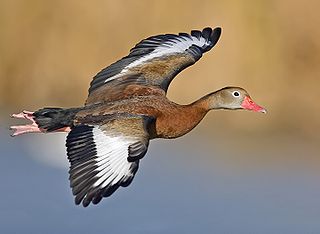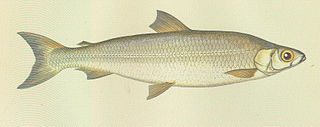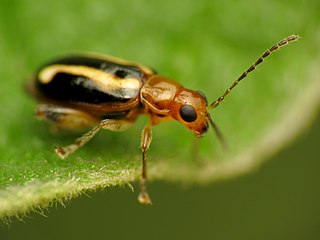
The black-bellied whistling duck, formerly called the black-bellied tree duck, is a whistling duck that breeds from the southernmost United States, Mexico, and tropical Central to south-central South America. In the US, it can be found year-round in peninsular Florida, parts of southeast Texas, coastal Alabama and Mississippi and seasonally in southeast Arizona, and Louisiana's Gulf Coast. It is a rare breeder in such disparate locations as Arkansas, Georgia, Tennessee, and South Carolina, though it is now a common breeder in parts of central Florida. There is a large population of several hundred that winter each year in Audubon Park in uptown New Orleans, Louisiana. Since it is one of only two whistling duck species native to North America, it is occasionally just known as the "whistling duck" or "Mexican squealer" in the southern USA.

The pollan or Irish pollan is a freshwater whitefish known only from five Irish lakes, Lough Neagh, Lower Lough Erne, Lough Ree, Lough Derg and Lough Allen. The pollan faces competition from introduced species such as pike, roach and zebra mussel, and the populations rely on restocking for survival.

Arctic cisco, also known as omul Russian: Омуль, is an anadromous species of freshwater whitefish that inhabits the Arctic parts of Siberia, Alaska and Canada. It has a close freshwater relative in several lakes of Ireland, known as the pollan, alternatively regarded as conspecific with it, or as a distinct species.

Mandragora officinarum is the type species of the plant genus Mandragora in the nightshade family Solanaceae. It is often known as mandrake, although this name is also used for other plants. As of 2015, sources differed significantly in the species they use for Mandragora plants native to the Mediterranean region. The main species found around the Mediterranean is called Mandragora autumnalis, the autumn mandrake. In a broader circumscription, all the plants native to the regions around the Mediterranean Sea are placed in M. officinarum, which thus includes M. autumnalis. The names autumn mandrake and Mediterranean mandrake are then used. Whatever the circumscription, Mandragora officinarum is a perennial herbaceous plant with ovate leaves arranged in a rosette, a thick upright root, often branched, and bell-shaped flowers followed by yellow or orange berries.

Ellychnia is a genus of fireflies. First defined by Émile Blanchard in 1845, the genus contains 24 species, which are widespread in the United States. Adults are black, with rose-colored marks on the pronotum; sexual dimorphism is unknown. These beetles are active during the day, and have no light-producing organs as adults; instead, they attract mates using chemical signals. The larvae of Ellychnia fireflies live in rotting logs.

Mandragora autumnalis, known as mandrake or autumn mandrake, is recognized by some sources as a separate species from Mandragora officinarum, although with different circumscriptions. Others regard it as merely part of this very variable species. Plants given the name Mandragora autumnalis consist of a rosette of leaves up to 60 cm (2 ft) across, close to the ground, with a central group of usually purplish flowers followed by yellow or orange berries. The large tap-roots as well as the leaves contain alkaloids and are toxic. They have traditional uses as herbal medicines.

Melolonthini is a tribe of scarab beetles in the family Scarabaeidae. There are over 250 genera in Melolonthini, occurring worldwide; there are over 300 species in North America alone, and more than 3000 worldwide.
Hydnobius is a genus of round fungus beetles in the family Leiodidae. There are about seven described species in Hydnobius.
Pachygnatha autumnalis is a species of long-jawed orb weaver in the spider family Tetragnathidae. It is found in the United States, Canada, and Cuba.
Gronocarus is a genus of May beetles and junebugs in the family Scarabaeidae. There are at least three described species in Gronocarus.
Trichotichnus autumnalis is a species of ground beetle in the family Carabidae. It is found in North America.

Trypodendron lineatum, known generally as striped ambrosia beetle, is a species of typical bark beetle in the family Curculionidae. Other common names include the two-striped timber beetle, conifer ambrosia beetle, and spruce timber beetle. It is found in Europe and North America.

Trogoderma variabile, the warehouse beetle, is a species of carpet beetle in the family Dermestidae. It is found in Europe, Asia, Central America, North America and Oceania.
Synetocephalus autumnalis is a species of skeletonizing leaf beetle in the family Chrysomelidae. It is found in North America.

Synetocephalus is a genus of skeletonizing leaf beetles in the family Chrysomelidae. There are about 10 described species in Synetocephalus. They are found in North America.

Atomaria is a genus of silken fungus beetles in the family Cryptophagidae. There are more than 160 described species in Atomaria.

Epeolus autumnalis, the cuckoo bee, is a species of cuckoo bee in the family Apidae. It is found in North America.
Pedicia autumnalis is a species of hairy-eyed crane fly in the family Pediciidae.
Lignyodes autumnalis, the fall forestiera weevil, is a species of leguminous seed weevil in the beetle family Curculionidae.

Odontria is a genus of beetle of the family Scarabaeidae.












